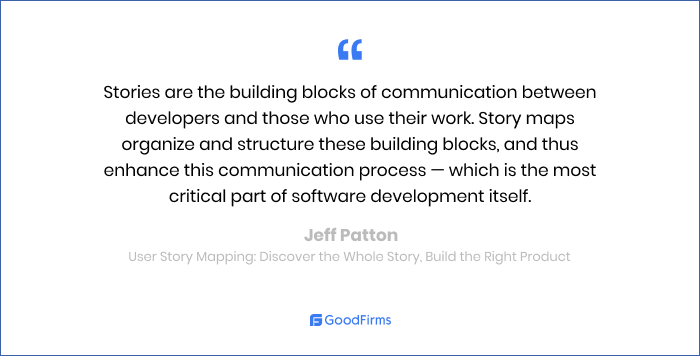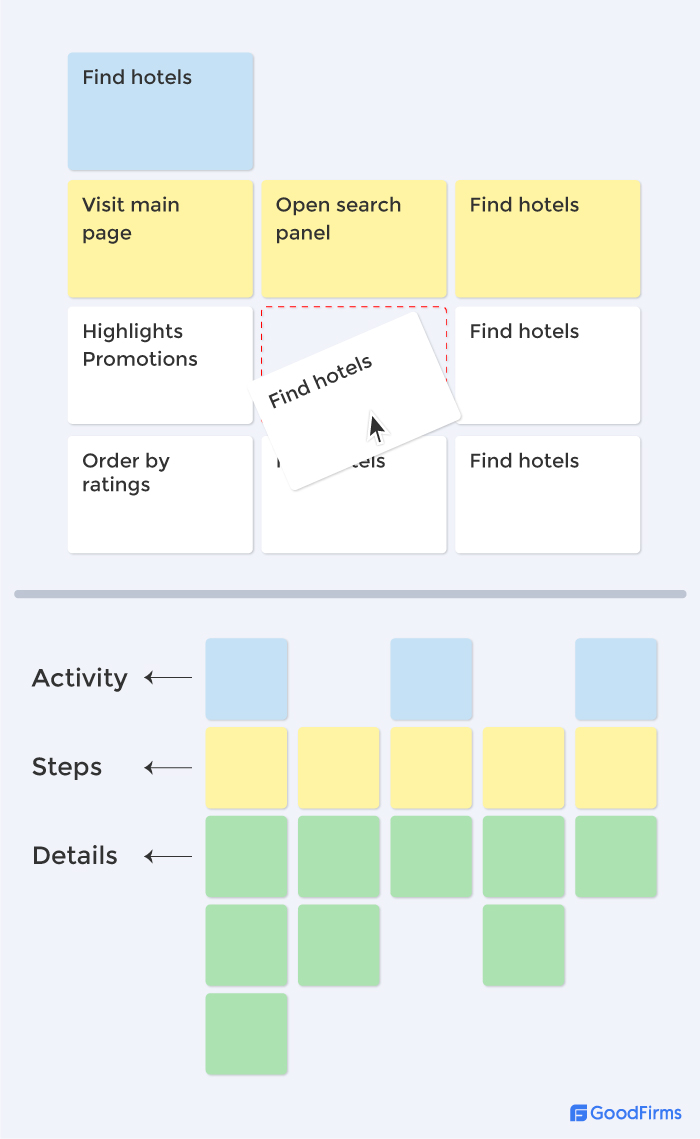If you've ever been on the fence about a new app or product, what’s the first thing you look for as a decision maker? Reviews and ratings, right? Having proper user information about a product and what it delivers usually helps the buyer tip in favor of purchasing the product.
This problem of lack of clarity of end-user requirements is a common hurdle that software app developers face from their clients during app development. And to solve this issue and repair the communication barrier between the app development team and end-users, software development companies rely on the agile methodology and create user stories.
What is a User Story?
A user story explains the features, uses, and benefits of a software product in an informal manner from the perspective of a user, highlighting the value it will create for the end user. It may seem like a user story only explains the software requirements and functions to the users, but that is not the case. It is written keeping in mind the end user, so it articulates the 'what’, 'why’, and 'how' in the form of a general conversation and not like an instruction manual.
The format could be as follows, “As a (user type), I want (product feature) so that i can (benefit of the digital product for the user)."

Here we can distinctly infer the tone of the sentence as informal while being informative about the software product. User stories offer background clarity without being too technical in nature, allowing room for creativity and interpretation. So the app developers gain clarity regarding what the user wants, why they want it, and how it will create value for them. Thus, user stories help app developers work in a user-centric framework.
How To Write A User Story: Story Mapping
Story Mapping is an extremely important step in writing user stories. A story map basically summarizes the experience users will have with the product, covering various aspects from beginning to end. Different stages can be added to the flow horizontally, and the finer details of each stage can be added vertically to make it more structural and easy to comprehend.
It can also be easily altered later during product development. It is especially useful in custom app development by top custom software app development companies.
A story map facilitates proper prioritization of development work and ensures that the user story follows a chronological path and doesn't stray from the underlying purpose of highlighting the core features of the application. “Stories are the building blocks of communication between developers and those who use their work. Story maps organize and structure these building blocks, and thus enhance this communication process — which is the most critical part of software development itself.”
-Jeff Patton,User Story Mapping: Discover the Whole Story, Build the Right Product

The process of story mapping requires both the client and the app development team to be present so that a wholesome discussion can take place. The following steps are usually followed during the story mapping process:
- Framing the problem that the software or app needs to solve for the end users. This is the objective of the business and the support it requires from the technical team. The end goal. Eg- Search for Hotels
- Determining the target audience for the app/ product. Who is the product aimed at and what are their preferences? Understanding the audience is key to the design of the app. Eg- Travelers
- Map the major activities of the target audience or end users of your app. These will be the main themes of your application. The backbone of the user story. Eg- Place of Vacation, or dates of Vacation.
- Map the minor activities undertaken by the users in the themes of your app. Break down into details. Eg- Comparing the prices of different hotels and their amenities.
- Re-Organize based on priority. Rearrange the order of activities on the map. Under each major theme, re-organize the minor activities in descending order of importance. Eg- Under the column of cities, hotels are based on discounts, followed by amenities, etc.
- Identify the gaps. The big picture with an organized structure should make it easy to identify any gaps that you missed, maybe in design or something else that you can now add or alter. Eg- Not a good color scheme for the app.
- Plan sprints and releases now that the stories are sorted from top down. You can actually move to execute the app development work.

The Elements Of An Excellent User Story
In agile mobile app development, different parts of the user story are undertaken by different teams (including app developers and product owners). In 2003, Bill Wake, the author of the 'Extreme Programming Explored and Refactoring Workbook’ ,invented and introduced the INVEST model system for writing user stories. It is a widely followed system for writing user stories that even the most renowned software and mobile app developers use. Here is the INVEST checklist for writing an excellent user story:
1. Independent
User stories must be independent from one another or they may later cause prioritization issues in the workflow. Interdependency of user stories will disrupt the flow of logical activities and will cause confusion when a product backlog arises.
Making user stories independent will allow developers to move them freely as their priorities shift during the development process.
2. Negotiable
A user story needs to be brief. It should not divulge the full product report but only a few core features and benefits for the end user. The purpose of the user story is to encourage further communication between the developers and clients about which features will be added or omitted. “Half a baked cake may not be enough to feed a wedding party, but it’s enough to taste and leave everyone looking forward to the rest of the cake.”
-Jeff Patton, User Story Mapping: Discover the Whole Story, Build the Right Product

3. Valuable
Without generating value for the users, there is no reason for user stories. The goal of the software is to create value for the users by solving a problem, and that should be reflected in the user story. The 'Why’ behind the development of the software product should be seen.
4. Estimate
The user story should convey the estimated story to the developers so that they can implement it. Without a clear understanding of the story, the developers won’t be able to create what you require adequately.
5. Small
Creating a user story should be a small project and not take up much of your time. You just need to keep it brief with all the minimal details so as to maintain an optimum story length.
6. Testable
The final point of the checklist involves the testability of the user story. The story should be testable and have an acceptance criteria. The acceptance criteria for successful development should be something objective. Avoid easy and vague criteria like "fast" or bug-free. If the story cannot be tested or fails in the acceptance test, it is not fit for implementation.
How Good User Stories Help Your Business: The Advantages
User stories are useful guidelines for your team to live up to your client’s expectations. They put the end-user at the center of their framework, which allows the developers to gain a better understanding and context of every feature required in the product and the value it should create for the customer.
“Documents usually describe what we need, but not why we need it.”
-Jeff Patton, User Story Mapping: Discover the Whole Story, Build the Right Product

Here are some of the advantages of user stories that will help you boost your business:
- User stories act as a bridge between the technical and non-technical members of the product development team to understand the client and user requirements.
- It helps shift the focus from just writing about the features of an app to discussing the value it creates for users.
- A lot of software projects fail because the developers fail to represent what the customer wants from the product. This can be avoided with the help of user stories that track and align every feature of the product with user needs.
- It is one of the most efficient ways to build an app from the ground up based on the user's perspective. Hence has a higher chance of success in the market.
- User stories drive verbal communication instead of lengthy documentation based feedbacks.
- An excellent user story facilitates good planning, designing, forecasting, and risk mitigation.
- User stories are an agile tool, implementing them will allow developers to work and finish on apps faster and more efficiently.
- With the user-centric approach, user stories help developers avoid any other brilliant but distractive ideas that they may have regarding the application or the software.
- User stories encourage participatory design, as both the developers and clients are invested in the story mapping process to engage end-users and their expectations.
- User stories allow space for creativity and alternate interpretations of different requirements of the end-users and how they can be tackled by the functions in the app.
Final Thoughts
User stories are abundantly used by all mobile app developers and in software projects globally. They are an important part of agile methodology and provide a platform to put the end-user in the center of the conversation. If implemented properly, user stories can prove to be excellent guidelines for the success of your app development project and team. User stories provide the opportunity for two different sets of professionals, the product owners and the developers, to collaborate in the development cycle of the product and improve communication between all the involved parties. Therefore, using this benefit-focused approach to developing an app can only help your business go forward.



